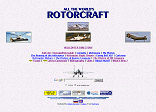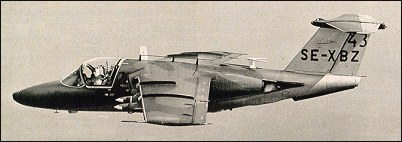|
| Developed by Saab as a private venture, to add to its product line a lightweight turbojet-powered aircraft able to fulfil a number of civil and military roles, the Saab-105 entered the design stage in 1959. However, it was not until 29 June 1963 that the first of two prototypes was flown, the long delay being caused by difficulties in finding a suitably small but powerful turbofan engine, eventually found in the 745kg thrust Turbomeca Aubisque. A cantilever-shoulder-wing monoplane easily recognisable by its marked wing anhedral and high T-tail, it has retractable tricycle landing gear, is powered by two turbofans nacelle-mounted one on each side of the fuselage, and has an enclosed cockpit that accommodates two side-by-side on ejection seats; alternative seating for four can be provided on fixed seats. Following extensive testing of the prototypes the Flygvapen placed an initial order in early 1964 for 130 production aircraft, a figure that was amended later to 150. The first of them was the Sk 60A trainer/liaison aircraft, flown initially on 29 August 1965 with deliveries for optional deployment in an attack role. The Sk 60B which followed was a dedicated attack version, and the designation Sk60C applied to a number of dual-role attack/reconnaissance aircraft, conversions from Sk 60Bs with a permanent camera installation. In addition to the foregoing, Saab built 40 aircraft for the Austrian airforce. Surviving Swedish air force Sk 60s, of which there are four squadrons, have undergone a life extension programme at Saab. A recently announced re-engining plan, utilising the WilliamsRJ44 turbofan, will see their useful lives extended even further. Saab entered a development of the 105 known as the Saab 2060, early in the USAF/USN JPATS competition, but failed to find a US partner for the design.
 | A three-view drawing (900 x 718) |
| CREW | 1-2 |
| PASSENGERS | 3-4 |
| ENGINE | 2 x GE J85-17B, 12.7kN |
| WEIGHTS |
| Take-off weight | 4000 kg | 8819 lb |
| Empty weight | 2583 kg | 5695 lb |
| DIMENSIONS |
| Wingspan | 9.5 m | 31 ft 2 in |
| Length | 10.5 m | 34 ft 5 in |
| Height | 2.7 m | 9 ft 10 in |
| Wing area | 16.3 m2 | 175.45 sq ft |
| PERFORMANCE |
| Max. speed | 770 km/h | 478 mph |
| Cruise speed | 700 km/h | 435 mph |
| Ceiling | 12000 m | 39350 ft |
| Range w/max.fuel | 1840 km | 1143 miles |
| ARMAMENT | 2350kg of weapons |
| roy manix, e-mail, 02.04.2012 22:56 i saw this plane at north weald around 1970... a beautiful looking plane .....never seen one since ..but would luv to>>> reply | | to moma, 17.10.2011 22:34 world to singggggggggggg reply | | salahalaqabi, e-mail, 28.03.2008 13:18 i need the dimensions of root and tip chord for the wing and the type of naca and the angles of wing at leading and trialing edge and dihadral angles i will thanks if can send me this information reply |
|
Do you have any comments?
|
| 
COMPANY
PROFILE
All the World's Rotorcraft
|







